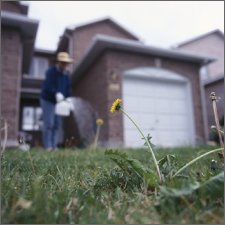The Danger of Household Insecticides Confirmed in Recent Study: What You Can Do Instead
by www.SixWise.com
A study by French researchers has found that using insecticides
-- either in the home or garden -- increases the risk of childhood
leukemia.
|

Your child's risk of harm from pesticide exposure is
highest while you're pregnant and in the early years
of his or her life.
|
The study, published in Occupational and Environmental
Medicine, included 280 children who had been newly diagnosed
with acute leukemia and another 288 children without the disease.
After interviewing each child's mother it was found that:
-
Children exposed to home insecticides while in the womb
or after birth had almost twice the risk of acute leukemia
as those who were not.
-
Children exposed to garden insecticides and fungicides
had double the risk of acute childhood leukemia.
-
Children who had been exposed to insecticidal shampoos
to treat head lice had almost double the risk.
A 2002 study published in Environmental Health Perspectives
found similar findings. Along with noting that children exposed
to professional pest control from one year before birth to
three years after birth had a significantly increased risk
of leukemia, the study found that:
-
Insecticide exposure early in life appears to be worse
for the child than exposure later in life.
-
The highest risk came from exposure during pregnancy.
-
The more frequent the exposure, the higher the risk.
Pesticides Increase Risk of Non-Hodkin Lymphoma
Yet another study, published in the journal Cancer, found
that children exposed (either in utero or after birth) to
household insecticides or professional extermination chemicals
within the home were three to seven times more likely to develop
non-Hodgkin lymphoma than children not exposed.
The risk of one type of lymphome, lymphoblastic lymphoma,
increased by 12.5 times after exposure to household pesticides.
|
 Lice
B Gone:™ The Safe Choice for Lice Removal Lice
B Gone:™ The Safe Choice for Lice Removal
- 100% Safe! Contains no harmful pesticides
or irritating chemicals.
- Highly Effective: Clinically proven to safely
remove lice and nits,
- Convenient: Easily applied with a handy pump
sprayer -- no waste, no mess.
- Very Economical: Lice B Gone™ provides
THE best value.
- Preventive Against Lice, Nits AND Fleas and Ticks:
Can safely be used for precautionary measures as often
as desired or needed.
Get More Information, including the
7
Reasons to Avoid Conventional
Lice Treatments Now!
|
"A limited number of these compounds may be capable
of inducing lymphoma, particularly when used around the home,"
said chief researcher Jonathan D. Buckley, M.B.B.S., Ph.D.,
from the Department of Preventative Medicine at the University
of Southern California in Los Angeles.
Children Especially at Risk from Insecticides
Exposure to pesticides, says Dr. Donald Mattison, of the
March of Dimes, can cause many short- and long-term problems,
including:
- Nervous system disturbances
- Agitation
- Insomnia
- Muscle weakness
- Respiratory agitation
|
- Nervousness
- Irritability
- Forgetfulness
- Confusion
- Depression
|
"Children are more vulnerable to the effects of pesticide
exposure because their internal organs are still developing
and maturing," said Dr. Mattison.
Further, because they play on the floor or lawn and put objects
into their mouths, they may be exposed to increased amounts.
And the List Goes On
|

Avoid using dangerous pesticides for aesthetic purposes
like dandelions in your lawn -- the health risks are
not worth it!
|
The potential health effects of pesticide exposure do not
end yet. Studies by the National Academy of Sciences and the
Environmental Working Group have found that children exposed
to carcinogenic pesticides are at a high risk of future cancer.
And animal and human studies of individual pesticides have
also uncovered the following risks:
Protecting Your Child and Family From Dangerous Insecticides
While it would be difficult to reduce your child's pesticide
exposure to an absolute zero, you can significantly reduce
it. One of the most important things to be aware of is to
avoid using conventional lice treatments on your child.
"Preparations like Rid and Kwell ... are definitely
toxic to people," says Dr. Andrew Weil, MD. That's because
they contain pediculicides, which are potent pesticides and
insecticides designed to poison lice, but that can be absorbed
directly into your child's scalp.
|
Keep Your Pets Safe From
Pesticides Too: Avoid
Commercial Flea Treatments!
 Flea
and tick control products can be extremely
hazardous, some containing highly noxious nerve gas.
Still, these products have approval to be sold because
the claim is that the amount of such hazards is minimal
in the products. Flea collars
and tags are literally soaked in chemical pesticides,
emitting a continuous toxic cloud into the air, not
only for your pet, but for you and your family. Flea
and tick control products can be extremely
hazardous, some containing highly noxious nerve gas.
Still, these products have approval to be sold because
the claim is that the amount of such hazards is minimal
in the products. Flea collars
and tags are literally soaked in chemical pesticides,
emitting a continuous toxic cloud into the air, not
only for your pet, but for you and your family.
Choose Flea 'n Tick B Gone instead: It's 100-percent
safe and does not contain harmful pesticides or chemicals.
- 100% pesticide free
- Non-toxic
- Clinically proven to be highly effective
- A Great Value! Eliminates the need for collars,
bombs, foggers, powders etc. and is economically priced
- Can also be used on bedding and pet areas of the
home -- Simply lightly spray in these areas
- Reduces vet and medicinal costs
- Can safely be used as a preventive against fleas
and ticks: regular use can naturally break life cycle
of fleas
- Controls other in-home pests
- Reduces risk of infections, dermatitis and itching
- Safely removes fleas, ticks, lice and other pests
Read
More and Order Now!
|
If your child does come home with a case of head
lice, we recommend you use Lice
B Gone™, a safe, non-toxic, 100 percent pesticide-free
multi-enzyme shampoo made from natural plant sources. This
extra-strength formula has been clinically proven to effectively
remove lice and nits without harmful pesticides or irritating
chemicals.
Along with avoiding conventional lice treatments, we also
recommend using the following strategies:
-
Buy certified organic fruits, vegetables and meats (be
sure to wash produce, particularly commercially grown
produce, thoroughly before eating using a diluted soap
solution).
-
Avoid the use of toxic pesticides in your home and yard
(opt for natural pesticides that you can find in your
local health food store instead).
-
If you are pregnant, nursing or have children in your
home, never use pesticides in your home or garden.
-
Avoid using conventional flea and tick collars and sprays
on your pets. Instead, we recommend the 100 percent non-toxic
and pesticide-free Flea
'n Tick B Gone.
-
Don't use pesticides for aesthetic purposes like dandelions
in your lawn.
-
Don't use chemical bug repellants or lice shampoos.
Recommended Reading
Organophosphates:
What You Don't Know Can Indeed Hurt You
Warning:
Phthalates in Cosmetics, Toys & More Can Pose Health Dangers
Sources
EurekAlert
January 16, 2006
Environmental
Health Perspectives. 2002 Sep;110(9):955-60
Child's
Exposure to Pesticides Hikes Lymphoma Risk
CBS
News: Protect Your Kids Against Pesticides